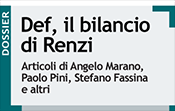Ultimi link in questa sezione
Movimenti di capitale, il Fondo ci ripensa
In contrast to most western governments, over the past two years, the International Monetary Fund (IMF) has boldly conducted one of the most honest self-assessments of its actions leading up to the financial crisis, has become somewhat critical of inflation-targeting and has endorsed the use of capital controls. In March of this year, the IMF held a full conference on rethinking macroeconomics where its organisers concluded that the crisis has shattered the economic orthodoxy behind the fund's previous policies.
In preparation for its annual meetings next week, on Tuesday the IMF took its work on capital controls a step further by issuing two reports (one official report and one staff discussion paper) outlining when nations should use capital controls, and what types of capital controls should be used under the proper circumstances. The new reports amount to yet another big step forward for the IMF – though there is still a long way to go.
In February 2010 the IMF changed its stance on capital controls because IMF economists' own analyses found that, over and again, when developing countries used capital controls, they worked. Indeed, the IMF found that those nations that used capital controls were among the least hard-hit during the crisis.
In a nutshell, the newest IMF report on controls does three things. First, it shows how post crisis capital flows to developing nations have been dominated by volatile portfolio flows and have therefore been destabilising, and that some nations resorted to capital controls to cope with those flows, with some success. Second, it importantly proposes a new nomenclature for capital controls, referring to them as capital flow management measures (CFMs). Third, it puts forth a set of guidelines for when nations should (and should not) deploy such measures and what form CFMs should take.
The first two components of the report are landmark for the IMF. The IMF has now recognised that capital flows can be destabilising – causing currency appreciation, asset bubbles and volatility – for developing countries. Their analysis of the recent use and modest success of controls by nations like Brazil confirms a preliminary analysis by one of us published last month where Kevin Gallagher found that controls in Brazil and Taiwan were associated with a reduction in the pace of currency appreciation and with helping those nations achieve a more independent monetary policy.
The IMF has also recognised that referring to these measures as capital "controls" brings great stigma. In earlier work, José Antonio Ocampo has referred to such measures as "capital account regulations", and other colleagues have called them "capital management techniques" (pdf) to the same end.
Where the report is lacking is in the IMF's determination of the efficacy of CFMs and what types should be used. The report recommends that CFMs be used as a last resort and as a temporary measure, and only after a nation has accumulated sufficient reserves, tinkered with interest rates and let its currency appreciate. When measures are used, the IMF suggests that CFMs not discriminate against the residency of a capital flow.
This has not been well-received in developing world. Without the advice of the IMF, many nations have deployed CFMs, both discriminatory and nondiscriminatory, alongside a host of other macroeconomic and macro-prudential policies as they have seen appropriate. And according to the IMF's own research, CFMs have been a success – even though they have sometimes not met those guidelines.
Interestingly, the accompanying IMF staff discussion paper is somewhat less strident, saying:
"there is no unambiguous welfare ranking of policy instruments (though nondiscriminatory prudential measures are always appropriate), and a pragmatic approach taking account of the economy's most pertinent risks and distortions needs to be adopted."
What is also disappointing from the report is what is not there. Even more importantly for setting guidelines for the use of CFMs, the IMF should focus at least equally on helping nations enforce such measures when they deem them appropriate. Many CFMs only work partially and for a short time because controls are evaded by foreign investors. Designing a regime to help nations enforce CFMs would be a welcome addition to the global financial system. Particularly important in this regard is to undo the de facto regime consisting of a tangled web of trade treaties that outlaw many CFMs.
This is also linked to the fact that the report does not follow through the implications of the statement that "the onus of policy adjustment from inflow surges rests solely on these countries." This is another area where the IMF could join a global debate (Gallagher has written on this with Stephany Griffith-Jones) on the extent to which capital account regulations could be coordinated on a global level – indeed, as part of the global process to re-regulate finance. It's worth recalling that in the meetings that led up to the establishment of the IMF, both Harry Dexter White and John Maynard Keynes agreed (pdf) that capital controls be targeted at "both ends" of a capital flow.
The IMF is to be applauded for taking another step towards a more integrative and development-friendly approach to global finance. It still has a way to go.










